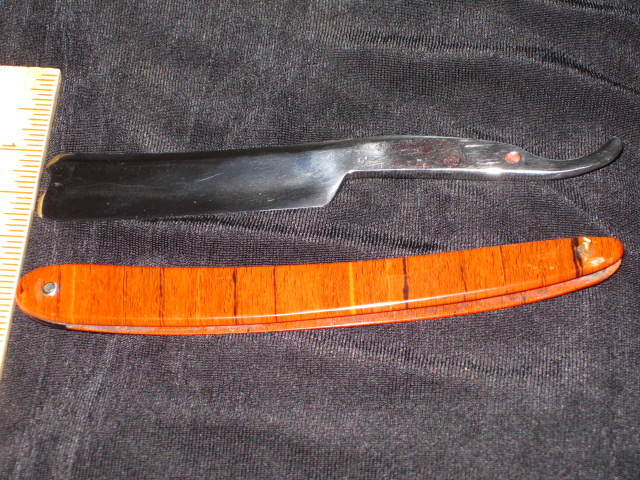Results 1 to 7 of 7
Thread: W&B first restore
-
08-30-2011, 11:22 PM #1Junior Member

- Join Date
- Jun 2011
- Location
- Rapid City SD
- Posts
- 25
Thanked: 2 W&B first restore
W&B first restore
First restoration, lots of questions.. I ran across this blade in an antique mall for $5.00 (there is a whole basket full.) It had more pits than the moon, but I was able to get them out with sand paper. Here is my questions, The Wade & Butcher stamp is very lightly stamped. Should I leave that area pitted to preserve the stamping? Is there anything wrong with using a dremel and flap sand wheels? Also, on the scales, how does a person properly remove a couple of light scratches and buff the scales? I really like the scales and there is nothing wrong with them. This W&B is a wedge @ 3/4". Thanks again for your help!!

-
08-31-2011, 12:09 AM #2

I would leave the pitting on the tang if your worried about losing it. Dremels you have to be VERY careful not to clip the edge. Flap wheels don't really work for this they are just to stiff. Lightly hand sand the scales with 800 grit and move up to 2000.
It's looking good. Keep at it.
-
08-31-2011, 01:49 AM #3

Like Trillium said, if you want the maker's mark leave the pitting. If you don't want the pitting, lose the maker's mark. For dremeling I like to use this neat little rubber flap wheel thing dremel has for it's EZ-lock system: ez lock wheel. It works really well, and it's easy to get in and clean on the shoulder because of the thinness of the wheel. I got mine from Lowes/HomeDepot for like 5-6 bucks. Of course you need the EZ lock mandrel too though... If you're going to use a Dremel, and haven't already, read up on the dangers of using one on a razor. You always want the wheel spinning so that it can't catch an edge. Search through the restoration forum for some info, definitely. Don't want to see your next post be "I can't believe what I just did" or "I only have 9 fingers now"! Good luck, and safe restoring!
-
08-31-2011, 02:38 AM #4..mama I know we broke the rules...



- Join Date
- Feb 2010
- Location
- Toronto, Ontario, Canada
- Posts
- 2,895
- Blog Entries
- 8
Thanked: 993
Trillium and adbuett have it. The decision is makers mark or no/little makers mark. That's your call.
Scales, the Dremel loose cotton wheel does a nice job. What are they made of? You can take 1000 grit to them lightly, and go up from there. Finish it off with Maas or a similar compound, and then buff out with your cotton dremel wheel.
I'm not big on the flap wheels myself. Dremel makes a sanding pad in three grits. It looks like a disk sink scrubby, but purple. It works fairly well...followed by hand sanding and polishing.
Good luck!
-
08-31-2011, 03:39 AM #5Junior Member

- Join Date
- Jun 2011
- Location
- Rapid City SD
- Posts
- 25
Thanked: 2
I do have a 6" variable buffing wheel, what compounds would work instead of the sanding disk?
-
08-31-2011, 02:06 PM #6Senior Member

- Join Date
- Jun 2011
- Posts
- 222
Thanked: 30
Leave some pitting on the tang. Nothing wrong with a blade showing some age. If you are going to clean that area, use a dremel with some emery just to take a little off to clean it up a bit.
If there are no deep scratches on the scales, then I tyipcally use black emery stick first. If that doesnt leave a clean the surface enough, then I will drop back to 600 Grit compound, follow with emery again, finish with white.
Depending on scale material be careful of the wheel grinding away the shaping of the scales. I usually try to use "fast passes" on my wheel until I get the desired results. Too long on one area and you can easily find yourself with a funny looking scale.
-
08-31-2011, 11:00 PM #7Junior Member

- Join Date
- Jun 2011
- Location
- Rapid City SD
- Posts
- 25
Thanked: 2
Ok, I'll give it a try. Hopefully I will b posting my completed "project" soon. Thanks again!!


 LinkBack URL
LinkBack URL About LinkBacks
About LinkBacks






 Reply With Quote
Reply With Quote